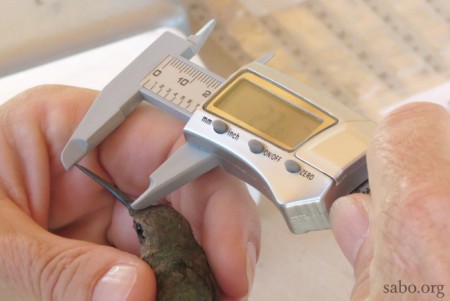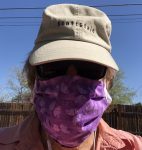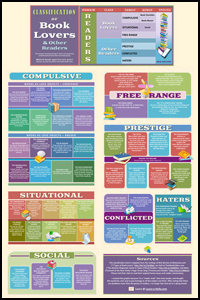A Bird in Hand
It’s a clear, sunny afternoon in the San Pedro National Conservation Area in southern Arizona, weepy cottonwoods barely stirring, just a few wispy clouds in the sky. Gazing treeward and cloudward is generally a major activity at this popular bird-watching spot just east of Sierra Vista, but the group gathered around a shaded picnic table is staring raptly downward. “That’s a big guy,” declares Sheri Williamson, the genial co-founder of the Southeastern Arizona Bird Observatory (SABO). She is sitting next to a miniature set of scales. “We don’t see many male Rufouses his size.”
“Big,” of course, is a relative term: The bird’s weight–carefully recorded by volunteer Rachael Brantley, along with characteristics such as beak length and coloration of throat and tail feathers–is 4.5 grams. A creature about the size of a thumb is being held aloft in a sling no longer than a Band-Aid.
But in the hummingbird world, this fella’s a pig.
My friend Bernadette and I are outside the preserve’s San Pedro House to take part in SABO’s hummingbird band-and-release program. Flitting between their tropical winter retreats in Mexico and central America and their nesting grounds in the upper United States and Canada–a journey that can span as many as 2,700 miles–almost a dozen different species of hummingbird stop off along the San Pedro River for a rest, a drink, and a nosh. By tracking their annual migration patterns, SABO is trying to determine whether the birds–and by association, their habitats–are being threatened.
I grew up in Brooklyn, where migrating birds meant pigeons visiting from New Jersey. I have no patience for standing around and staring at branches, trying to see something I’m not going to be able to identify–and why I would want to? Birding hasn’t exactly been at the top of my try-before-I-die list. But Bernadette, who’s done this before, swears it’s a lot of fun. I’m going along because hummingbirds are easy to recognize, and anything capable of eating twice its body weight in food each day has got my attention.
Getting these itty-bitty critters, which are not only speedy but also smarter than your average bird, into a position where tiny bands can be put on their tiny legs is challenging, to say the least. But the three SABO staff members–along with Williamson, her husband Tom Wood and naturalist Ron Hunt–have got it sussed. They use sugar water-filled feeders (“Forget the coloring and the pricey commercial stuff,” says Williamson, “clear sugar water works just as well”) to lure the birds into fine nylon mist nets, which they and the SABO volunteers watch vigilantly. As soon as a bird takes the bait, it’s chased to the back of the net, placed into a mesh bag, and carefully carried over to the table, where the weighing in and measuring commence.
Hunt, who’s on net watch, waxes rhapsodic when asked about Southeastern Arizona and the “sky islands” formed by the many mountains and rivers crisscrossing the region. It seems that features of the lower Rockies and the upper Sierra Madres, as well as of the Mojave, Chihuahuan and Sonoran deserts, all converge here. “It’s one of the world’s great bio-diverse regions,” he enthuses, “as interesting to many naturalists as the Serengeti Plains or the Galapagos Islands.” You won’t find huge animals anymore, although mammoths and mastodons used to roam the area, but there are more than 450 different species of birds and almost 300 types of butterflies.
The small group surrounding Williamson is now watching her measure an Anna’s hummingbird, slightly larger than the Rufous and green with patches of black and gray. Seeing the bird at close range, I’m amazed at its iridescent throat colors, flaming pink shading into psychedelic red and orange. According to Williamson, these flashy feathers indicate that the bird is an adult male. He uses them not only to attract females but also to frighten off other males–“kind of like gang colors,” she says, adding that the male birds tend to do a lot of mouthing off but little follow up. “You do see them body-slamming each other on occasion, but most of the time, one of them punks out and just flits away.”
Although the aluminum band that Williamson twists into place on the Anna’s leg is minuscule–about the diameter of an eyeglass screw–she contends that hummingbirds are actually easier to deal with than many larger birds. They’re not as dangerous to handle as, say, birds of prey, and not as vulnerable in many ways as shorebirds and songbirds that have long, fragile legs. The hummingbird’s intelligence–it’s got quite a large brain relative to its body size–and its fearlessness also keep it from getting overly stressed during the banding process.
Still, the poor little things are bound to be traumatized after being manhandled by various featherless giants. As soon as Williamson completes her measurements, each bird is handed over to 8-year-old Erin Hodges, who holds it up to a feeder for a shot of sugar water–a parting energy boost, as well as a reward for being poked and prodded. Then the bird is gently passed along to another volunteer, whose open, outstretched hand serves as a bird-launching pad. It usually takes a hummingbird about half a minute to realize it’s finally free to flee.
Now it’s my turn. Yikes. I’ve been enjoying myself, but I haven’t been channeling Dr. Doolittle. What if my nervousness somehow makes the bird even more agitated? But the Anna’s doesn’t seem to be aware that I’m obsessing. He just settles in on my hand, making a sound that feels like purring (that’s his rapid heart beat, I’m told). Some of the others come over to stroke him, including a small boy who seems a bit aggressive in his pokings–OK, so I’m starting to feel protective–but most of the group just looks on, amazed. By the time my cutie finally flies away, it’s a clocked 10 minutes later. According to Erin, who’s been helping out at SABO bandings since she was 5, I’ve broken some kind of hummingbird-lingering record.
“Maybe your hand was sticky,” little Poking Boy suggests.
I don’t care. I’m thrilled, and I know the truth, although it flies–or, should I say, rests–in the face of my Brooklyn-bred cynicism. That hummingbird liked me. He really liked me.
–Originally published in America West inflight magazine
The San Pedro House visitor center of the San Pedro Riparian National Conservation Area is 7 miles east of Sierra Vista on Route 90. Banding usually takes place Saturday afternoons from about early April to early June, then again from early July through September; you’ll see the greatest numbers and greatest diversity of species from mid-August through the end of September. The sessions are open to the public at no charge, but donations are gratefully accepted. The Bisbee-based Southeastern Arizona Bird Observatory–(520) 432-1388; www.SABO.org–runs a variety of for-fee bird-watching tours, walks and workshops, many involving avians other than hummingbirds.











